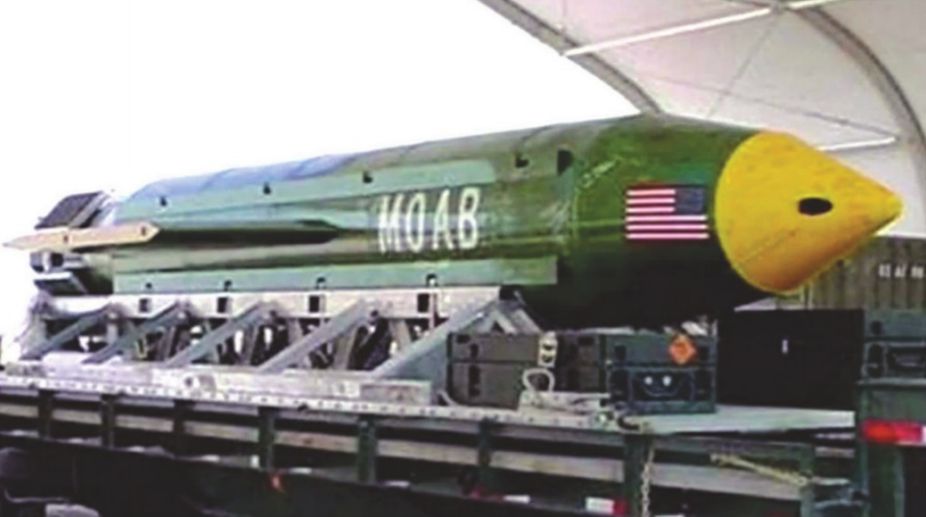NASA head Nelson says China hiding military presence in space
"I think that we just better not let down our guard," Nelson added.

MOAB (PHOTO: SNS)
The actual use of one of the most destructive non-nuclear bombs in Afghanistan, reports of the use of chemical weapons in Syria, the disturbing recent discussion on the threat of use of extremely destructive weapons in places such as the Korean peninsula have again focused attention on the extent to which the race for destructive weapons is threatening humanity and all other forms of life on earth.
When a hugely destructive bomb known as the mother of all bombs (MOAB) was dropped in Afghanistan on 13 April, it was described as the first combat use of the biggest nonnuclear explosive. This bomb officially known as GBU 43/B Massive Ordnance Air Blast weighs 10,000 kg and its blast yield is equivalent to 11 tons of TNT.
While the destructive capacity of this bomb was being discussed came news that Russia has a non-nuclear weapon of even higher destructive capacity. This weapon is officially called the Aviation Thermobaric Bomb of Increased Power but is more generally known as the Father of all Bombs. Although lighter in weight than the MOAB, its blast yield is about four times greater or the equivalent of 44 tons of TNT.
Advertisement
Massively destructive as it is, this is no match for nuclear weapons – the nuclear bomb which destroyed Hiroshima had a blast yield equivalent to about 15,000 tons of TNT. In Hiroshima, the temperature at the hypocenter of the explosion reached twice what it takes to melt iron. The face of a girl sitting one kilometer away from this hypocenter was burnt beyond recognition.
Nearly 100,000 people were killed within a few minutes of being hit by nuclear weapons at Hiroshima and Nagasaki in 1945. In subsequent years many more people died even more painful deaths due to longer-term impacts. This included deaths caused by internal bleeding, leukemia and various other forms of cancer. In addition there were a large number of children born with mental retardation, physical deformities and other serious health problems.
In view of all this, it is truly frightening to think that weapons many times more destructive than the ones used in Hiroshima and Nagasaki are likely to be unleashed in even a limited nuclear war in future. While fullblown nuclear weapons have not been used after 1945, depleted uranium weapons have been used, most frequently by the USA, in counties such as Iraq, Afghanistan and possibly also Bosnia.
Due to the longer-term impacts of depleted uranium weapons on innocent civilian populations, there has been a large increase in cases of leukemia and childhood cancers in several parts of Iraq in particular. Another impact has been the birth of many malformed babies.
A secret report prepared by the United Kingdom Atomic Energy Authority (later published in the Independent) described the alarming possibilities of radioactive dust getting into the food chain and water following the use of depleted uranium weapons. This report warned that 40 tons of radioactive debris left from depleted uranium weapons could cause around half a million deaths.
Even American soldiers who used depleted uranium weapons or later moved around in areas where these had been used suffered from several long-term and serious health impacts. Those workers or soldiers who are asked to clean up contaminated sites have been exposed to serious health hazards. A former US army officer told an American magazine that when he and his soldiers were assigned to clean up one such area they stated getting sick within 72 hours – “respiratory problems, rashes, bleeding, open sores started almost immediately.”
Indeed there is a possibility that apart from ruining the health of people directly exposed to these depleted uranium weapons, these could have very harmful impacts on entirely unsuspecting people even in other countries. This can happen if some of the war-time debris and junk including some dust are auctioned and so get transported to other countries.
Some reports have appeared from time to time in India’s media about explosions taking places in places where scrap and junk material including imported scrap and junk are stored. This raised the possibility that auctioned war debris from Iraq which contained remains of explosives had reached India among other places. This is the less sinister part of such contaminated war debris. A much bigger hazard exists in the form of hidden contamination by depleted uranium. Hence the import of war debris should be strictly banned.
Given all these dangers of nuclear or depleted uranium weapons, all those who value human life and other forms of life have been getting nervous and restless whenever the threat of such weapons appears as happened recently when the Korean crisis accentuated. Apart from praying for better sense to prevail, people can also play an active role by joining up with wider peace efforts and movements working for peace and disarmament at various levels and in various ways to bring some sanity in our increasingly troubled world.
The writer is a freelance journalist who has been involved with various social movements and initiatives
Advertisement